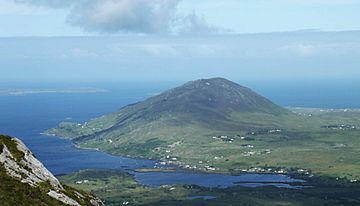Tully Mountain (Ireland) facts for kids
Quick facts for kids Tully Mountain |
|
|---|---|
| Cnoc Leitreach | |
 |
|
| Highest point | |
| Elevation | 356 m (1,168 ft) |
| Prominence | 331 m (1,086 ft) |
| Listing | Marilyn |
| Geography | |
| OSI/OSNI grid | L6727261173 |
| Climbing | |
| Easiest route | Hike |
Tully Mountain, also known as Letter Hill, is a large and beautiful hill in County Galway, Ireland. It stands tall near the coast, not far from the village of Letterfrack. This mountain is about 356 meters (1,168 feet) high. It is so special that parts of it have been named a Special Area of Conservation to protect its unique nature.
Contents
Exploring Tully Mountain
Tully Mountain is 356 meters (1,168 feet) high. It really stands out on the Renvyle Peninsula. You can see it clearly from places like Ballinakill harbour to the south. It also offers great views towards Inishbofin island in the west and Crump Island to the north.
At the very top of the mountain, there is a small pile of stones called a cairn. From here, you get amazing views all around. You can see the Twelve Bens mountain range and the coastlines of north Connemara and Mayo. You can also spot Inishbofin and other islands.
Tully Mountain and a nearby lake, Tully Lough, get their names from Tully village. This village is located on the north-eastern side of the mountain. The path to the top of Tully Mountain is not difficult. You do not need any special hiking skills to enjoy the walk.
Plants and Animals of Tully Mountain
The mountain is made of old rocks called schists and gneisses. You will see many rocky areas and grassy uplands. There are also areas with special plants called alpine and subalpine heaths. These plants are used to living in high, cool places.
On the lower parts of the mountain, sheep have eaten a lot of the grass. You might also see thick patches of a fern called bracken. Higher up, above 300 meters (984 feet), the dry heath areas are home to interesting plants. These include juniper and bearberry. You will also find different types of heather, such as bell heather, St. Dabeoc’s Heath, and cross-leaved heath. Many lichens and mosses also grow here. This mix of plants is quite rare in the west of Ireland.
Some flatter, wet grassy areas have plants like soft rush and bog mosses (Sphagnum). You might also spot plants like bladderwort. In wet, flowing areas, you can find sedges, more bog mosses, bog pimpernel, and sundews.
Ancient History of Tully Mountain
The area around Tully Mountain has many signs of people who lived there long ago. These are called pre-historic remains. For example, there is a type of ancient burial place called a court tomb. There is also a line of standing stones, known as a stone alignment, located between the mountain and Tully Lough. These show that people lived and built things here thousands of years ago.
Protecting Tully Mountain
Tully Lough and the north-eastern slopes of Tully Mountain are very important. They have been chosen as a candidate Special Area of Conservation. This means they are being considered for special protection under the EU Habitats Directive. This directive helps protect natural habitats and the wild plants and animals that live there. Tully Mountain itself has already been officially listed as a Special Area of Conservation. This helps make sure its unique environment is kept safe for the future.


